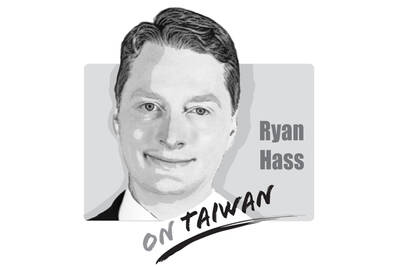Newly elected Chinese Nationalist Party (KMT) Chairman Eric Chu (朱立倫) should try to reconnect the party with Taiwanese society, or the KMT might never leave behind its role as an ineffective opposition.
The party’s chairperson election had been neglected by most Taiwanese until one of the four candidates, Sun Yat-sen School president Chang Ya-chung (張亞中), drew unprecedented attention with his vehement rhetoric during a televised debate on Sept. 4, appealing to far-right deep-blue supporters.
A TVBS poll conducted in the days after the debate showed that Chang had taken the lead from the more centrist Chu, a former New Taipei City mayor who led the party from 2015 to 2016, while incumbent KMT Chairman Johnny Chiang (江啟臣) had only 12.8 percent support.
Chu’s return to the chairmanship raises the question of whether he can give the KMT a new direction after Chiang’s leadership proved ineffective.
Ahead of the vote, Chiang said in a radio interview on Friday that the KMT chairman would have to work on a host of urgent tasks, including stabilizing the party, gearing up for four referendums in December, next year’s local elections and the 2024 presidential election.
While former Kaohsiung mayor Han Kuo-yu (韓國瑜) did not publicly lobby for any of the four candidates, his shadow fell over their campaigns.
Chiang told the interviewer that he had spoken to Han by telephone, quoting him as saying that he did not favor any of the candidates. The statement was directed at Chu, who had often been seen with former Han aides on the campaign trail and had said that he was also in contact with Han.
Although Han was defeated by President Tsai Ing-wen (蔡英文) in last year’s presidential election and recalled by Kaohsiung voters a few months later, many KMT members still seem impressed by his ability to rally hundreds of thousands of supporters during his presidential campaign.
However, if the KMT remains unable to respond to the needs of Taiwanese society and remains obsessed with the craze about Han — a populist known for his inflated performances — the party will remain in opposition for many years to come.
The KMT leadership should switch its attention to the nation’s primary problems and ask itself whether the party can present better solutions than the Democratic Progressive Party (DPP).
While many countries are reopening their borders after COVID-19 travel restrictions, Taiwan’s strategy to safely follow suit needs deliberation. Whether the government has used relief funds efficiently also requires monitoring.
Meanwhile, the government has applied to join the Comprehensive and Progressive Agreement for Trans-Pacific Partnership (CPTPP). Many thorny issues are ensuing, including whether to lift a ban on certain food imports from Japan and how to mitigate the potential effect of joining the bloc on domestic industries.
It is time for the KMT to set aside its hostility toward Japan and demonstrate its ability to monitor the government’s CPTPP membership negotiations. Following its messy battle against US pork imports, the KMT should resort to rational and scientific arguments about Japanese food imports.
However, addressing its relations with Beijing perhaps remains the biggest challenge. At a time when more countries are joining the US’ efforts to rein in China’s hegemonic ambitions, the KMT needs to convince Taiwanese that it is not pro-China and is unwilling to sell out Taiwan, as the DPP claims.
With ever fewer Taiwanese being nostalgic about China — and the so-called “1992 consensus” being rejected by most members of the public, in which a majority identifies as Taiwanese, not Chinese — the KMT’s insistence on the “consensus” rings hollow.

There has been much catastrophizing in Taiwan recently about America becoming more unreliable as a bulwark against Chinese pressure. Some of this has been sparked by debates in Washington about whether the United States should defend Taiwan in event of conflict. There also were understandable anxieties about whether President Trump would sacrifice Taiwan’s interests for a trade deal when he sat down with President Xi (習近平) in late October. On top of that, Taiwan’s opposition political leaders have sought to score political points by attacking the Lai (賴清德) administration for mishandling relations with the United States. Part of this budding anxiety
The diplomatic dispute between China and Japan over Japanese Prime Minister Sanae Takaichi’s comments in the Japanese Diet continues to escalate. In a letter to UN Secretary-General Antonio Guterres, China’s UN Ambassador Fu Cong (傅聰) wrote that, “if Japan dares to attempt an armed intervention in the cross-Strait situation, it would be an act of aggression.” There was no indication that Fu was aware of the irony implicit in the complaint. Until this point, Beijing had limited its remonstrations to diplomatic summonses and weaponization of economic levers, such as banning Japanese seafood imports, discouraging Chinese from traveling to Japan or issuing
The diplomatic spat between China and Japan over comments Japanese Prime Minister Sanae Takaichi made on Nov. 7 continues to worsen. Beijing is angry about Takaichi’s remarks that military force used against Taiwan by the Chinese People’s Liberation Army (PLA) could constitute a “survival-threatening situation” necessitating the involvement of the Japanese Self-Defense Forces. Rather than trying to reduce tensions, Beijing is looking to leverage the situation to its advantage in action and rhetoric. On Saturday last week, four armed China Coast Guard vessels sailed around the Japanese-controlled Diaoyutai Islands (釣魚台), known to Japan as the Senkakus. On Friday, in what
On Nov. 8, newly elected Chinese Nationalist Party (KMT) Chairwoman Cheng Li-wun (鄭麗文) and Vice Chairman Chi Lin-len (季麟連) attended a memorial for White Terror era victims, during which convicted Chinese Communist Party (CCP) spies such as Wu Shi (吳石) were also honored. Cheng’s participation in the ceremony, which she said was part of her efforts to promote cross-strait reconciliation, has trapped herself and her party into the KMT’s dark past, and risks putting the party back on its old disastrous road. Wu, a lieutenant general who was the Ministry of National Defense’s deputy chief of the general staff, was recruited